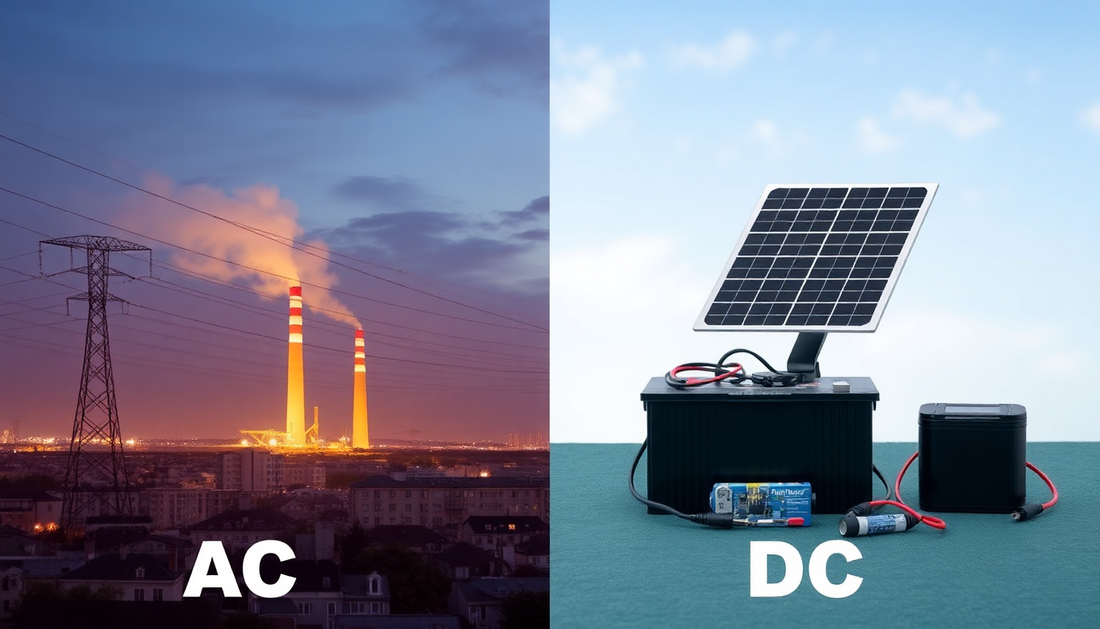
AC vs. DC Power Comparison: What You Need to Know
Share
Introduction
Electricity is essential to modern life, powering everything from the devices in our homes to large industrial machines. Two main types of electrical current are used worldwide: alternating current (AC) and direct current (DC). While both forms are widely used, they differ significantly in how they deliver power and where they are applied. In this blog, we’ll explore the key differences between AC and DC power, their respective advantages, and where each type is most commonly used.
You might also find these blogs helpful:
What's the difference between Wire and Cable
What's the difference between Speaker and Instrument Cables
What's the difference between Home and Vehicle Circuit Breaker

What is AC Power?
Alternating Current (AC) is a type of electrical current where the direction of the flow of electrons switches back and forth periodically. The voltage level in an AC system also varies, forming a wave-like pattern. AC is generated by power plants and is what we typically use in our homes and offices. In North America, the standard AC frequency is 60 Hz (60 cycles per second), while in many other parts of the world, it's 50 Hz.
Key Characteristics of AC Power:
- Alternating flow: The current changes direction multiple times per second.
- Frequency: In the U.S., AC electricity operates at 60 Hz, meaning the current changes direction 60 times per second.
- Voltage: AC voltage levels rise and fall in a sinusoidal (wave-like) pattern.
Applications of AC Power
AC power is the most widely used form of electricity in homes, businesses, and public infrastructure due to its ease of transmission and flexibility in voltage levels.
- Household Power Supply: Almost all household electrical systems are powered by AC. This includes lights, appliances, HVAC systems, and more.
- Commercial and Industrial Systems: AC is commonly used to power large machines, industrial systems, and commercial buildings because it can be transmitted over long distances efficiently.
- Power Grid Transmission: High-voltage AC is ideal for long-distance transmission from power plants to homes and cities.
Why AC is Better for Long-Distance Transmission
One of the major advantages of AC power is that it can be easily transformed to higher or lower voltage levels using a transformer. For long-distance transmission, the power is stepped up to very high voltages, reducing the current and minimizing energy loss during transmission. At the point of use, the voltage is stepped down to safer levels for homes and businesses.
In contrast, DC power is harder to step up to high voltages and experiences more significant energy losses over long distances. This is one of the reasons AC was chosen for power grids.

What is DC Power?
Direct Current (DC) is a type of electrical current where the flow of electrons is constant and unidirectional—moving in a straight line from the power source through the circuit. DC is commonly found in batteries, solar panels, and other small-scale electrical systems. Unlike AC, DC provides a steady voltage that doesn't fluctuate.
Key Characteristics of DC Power:
- Unidirectional flow: The current flows in one direction from positive to negative.
- Constant voltage: DC provides a stable voltage with no fluctuations or frequency.
- Common in low-voltage applications: Batteries, electronic devices, and solar systems use DC power.
Applications of DC Power
DC power is most often used in small-scale and low-voltage applications where stable voltage and direct control are needed.
- Batteries: Most batteries supply DC power, making them ideal for powering portable devices such as smartphones, laptops, and flashlights.
- Electronics: Almost all electronic devices, such as computers, TVs, and small appliances, run on DC power. These devices typically convert AC from wall outlets into DC using adapters or power supplies.
- Solar Power Systems: Solar panels generate DC electricity, which is often converted into AC using an inverter for home use or sent back to the grid.
Why DC is Often Used in Electronics and Vehicles
Although AC is better for long-distance transmission, DC has advantages in applications that require stable and precise voltage. Many electronic devices rely on DC for their circuits because it provides a steady voltage, which is critical for sensitive components. This is also why cars, trucks, and other vehicles use DC power supplied by batteries to operate their electrical systems.

Key Differences Between AC and DC Power
| Feature | AC (Alternating Current) | DC (Direct Current) |
|---|---|---|
| Flow of Electrons | Alternates direction periodically | Flows in one constant direction |
| Source | Power plants, electrical outlets | Batteries, solar panels, power adapters |
| Transmission | Long-distance transmission is efficient | Less efficient for long-distance transmission |
| Voltage | Varies in a sinusoidal wave | Constant voltage level |
| Frequency | 50 Hz (Europe) or 60 Hz (USA) | Zero frequency, no change in direction |
| Typical Uses | Homes, offices, large appliances | Portable electronics, vehicle systems |
Conversion Between AC and DC
In many applications, devices must convert between AC and DC power. Common examples include:
- Rectifiers: Devices that convert AC to DC, typically found in power adapters for electronics.
- Inverters: Devices that convert DC to AC, commonly used in solar power systems to feed electricity into the power grid or power AC appliances.

Conclusion
Both AC and DC power have important roles in our everyday lives, with each type of current being suited to different applications. AC is ideal for powering homes and transmitting electricity over long distances, while DC excels in portable electronics, batteries, and vehicles. Understanding the differences between AC and DC power can help you make informed decisions when working with electrical systems and selecting the right type of power for your needs. Whether you’re wiring a new home system or installing a solar panel setup, knowing when to use AC or DC is crucial for safe and efficient operation.








